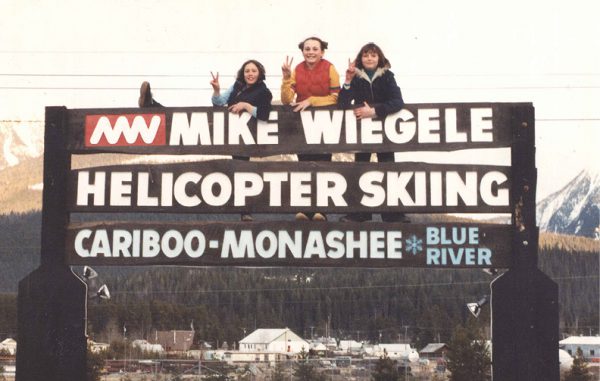WE’RE KNEE-DEEP IN HOW SKI LIFE HAS EVOLVED AFTER 50 YEARS OF HELI-SKIING.
BY LESLIE WOIT
No radio, no avalanche transceiver, no veggie options… Take my hand as we travel back in time to 1970. You’re humming that new tune “Bridge Over Troubled Water” as you squeeze your tight little package into those navy Pedigree stretch pants and snap into some newfangled plastic Kastingers. Clambering into the middle seat of a bubble-licious Bell 47, we’re whisked like magic to the top of a mountain and, presto, you are among the first people in the world ever to heli-ski with Mike Wiegele. Part Star Trek, pure Jetsons, this is far out and right on and bad, bad, bad. Who cares when the powder is this good? Let the good times roll, baby!
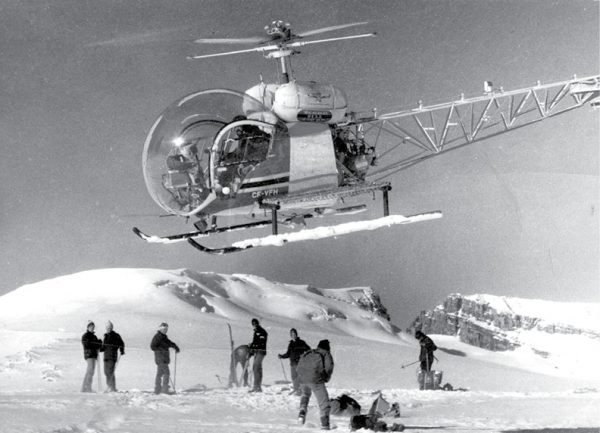
REV ’ER UP
This classic flying machine, a Bell 47, may look like it was glued together in someone’s garage, but at the time it certainly beat walking up. For the record, the very first use of a helicopter for skiing was in 1963 when Hans Gmoser flew up into Kananaskis, but Wiegele was quickly onto a good thing. In 1970 he hung out his shingle in Valemount, B.C., and headed high into the Cariboo Mountains. Shortly after, he found more snow and less wind when he relocated an hour up the highway to Blue River, about halfway between Kamloops and Jasper. Today, it’s the Bell 212 twin engines that are the workhorses of the mountains, alongside snazzy powerful A-Stars, the Ferrari of the skies.
SHARING POWDER
An eye-wateringly large tenure of 6,000 sq km and 50 years of making tracks didn’t just happen. Tracing his finger along the table, Wiegele draws an imaginary line to demonstrate how the heli-ski world was carved out by its first pioneers, long before the early 1980s when the provincial government issued the first legal tenures for recreational land use by heli-ski operators.
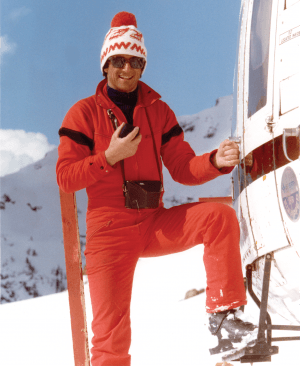
“We took a pencil and divided up the best terrain,” explains Wiegele of the early arrangements beaten out with Hans Gmoser of Canadian Mountain Holidays (CMH). “And we said, ‘Hey, you got a little too much there, I’ll take that, and vice versa’,” describing a gentlemen’s agreement between two mountain guides that belied their fiercely competitive natures. Wiegele went head-to-head with Gmoser—as only Austrians can—and by 1974 two more guides, Rudi Gertsch and Peter Schlunegger, would open their own operations, too—Purcell Heli-Skiing and Selkirk Tangiers.
While CMH grew to 12 individual lodges, Wiegele expanded his tenure into what would be the largest single helicopter skiing area in the world, stretching about 128 km from north to south and some 64 km east to west. Today as many as 12 helicopters lift and land on more than 1,000 named routes, pinning runs such as Steinbock and Most Magnificent onto the maps of the world’s heli-skiing elite.
Over the years, that first fistful of Austrian and Swiss post-war émigrés has evolved to a current-day association of more than 20 heli-skiing operations in B.C. run by a new breed of mostly Canadians and spawned further outfits around the globe. From India, Iceland and the Alps, to Greenland, Russia, the Stans and Down Under, what began in Canada has gone global.
SOUNDS LIKE A SAFE BET
With growth, came increasingly rigorous safety measures. In the 1970s, Wiegele was introduced to Pieps avalanche beacons at an ICAR (International Commission for Alpine Rescue) conference and soon became the first heli-operator in North America to include the Pieps brand avalanche transceiver in mandatory safety protocol. His safety infrastructure expanded to include three weather stations, three radio repeater stations and an avalanche research program with the University of Calgary.
LAST ONE DOWN’S A TAIL GUIDE!
While the industry standard is 11 guests to one guide, for decades Wiegele has provided groups of 10 skiers with two guides—lead and rear. There are also doctor-guides on staff, and more female guides than ever. If you ask nicely, you might get to see Wiegele’s fire truck or, more impressively, the massive heated hangar facility located at the end of the private airstrip. Drake, eat your heart out.
SKINNY’S OUT, FAT’S IN
If you’re sufficiently vintage to remember tackling powder on long skinny skis—the twisted backs, thigh pain, tangled bits of string—kudos to you. If you’re a post-1992 heli-skier, you’ll never know how good you have it. In the mid ’90s, Wiegele’s long friendship with ever-jolly Rupert “Killy” Huber of Atomic bore fruit. Thanks to Huber’s wacky experiments bisecting snowboards in his workshop, labs and around the Stammtisch in Altenmarkt, Austria, fat skis are now the answer to our deep-snow dreams. In 1994, the smiley Wohlgemuth brothers from Whistler, B.C., made synchro-tastic headlines by winning the World Powder 8 Championships at Wiegele World on a pair of 180 Atomic Fat Boys. A quarter-century on, rockers, different flexes and varying widths mean we’re not simply assigned one pair of skis for the week anymore. Daily choices suit varying snow conditions with no bother, no fuss, thanks to the awesome ski shop guys and Wiegele’s ski valet service that delivers direct to your helipad.
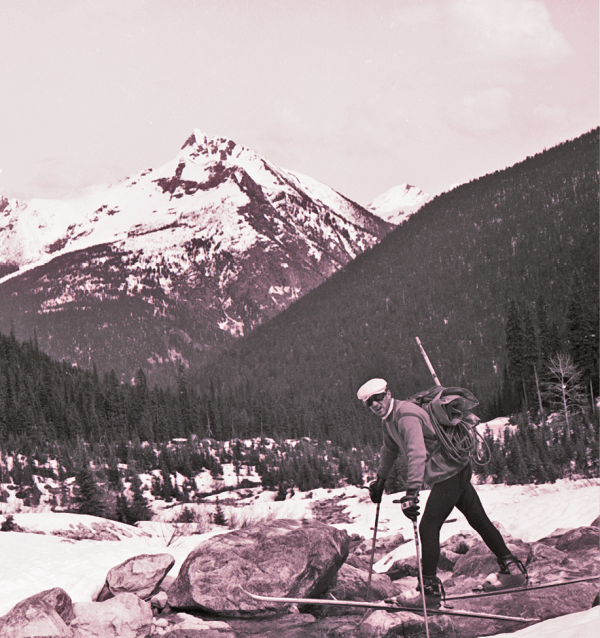
NO MORE JAIL TIME
Ah, the good ol’ days. Behind bars in a cell of one’s own at the disused police station. Or perhaps getting jiggy in an orange shag motel room with a lavender hopper (and those were the renovated ones). That’s how early heli-skiing rolled in Blue River until the first guest chalets were built in 1980. From that moment, there has been no stopping Wiegele’s building fetish: from log cabins with fireplaces and private baths, to luxurious chalets with steam showers and walk-in/walk-out helipads. The ever-expanding village is now an alpine sprawl of 22 chalets accommodating more than 100 heli-skiers at a time; a massive main lodge with dining room, lounge, fitness centre, stretch room and massage therapy clinic; plus a guides building with a medical clinic, and a reception building.
AND THEN THERE WERE GIRLS
Back in the early ’80s, women accounted for a scant two to three per cent of heli-skiers. Today current industry tallies count them closer to a third of the clientele.
LEAVE YOUR CROWN AT THE DOOR
Celebs and royals can’t get enough of Wiegele’s deep powder and long wine lists. The guest manifest has long featured a tony set of doctors, dentists and dealmakers, alongside ski royalty icons Jake Burton and Marcel Hirscher, Hollywood ones like Kiefer Sutherland, as well as more conventionally crowned heads such as Princess Caroline of Monaco, Prince Ernst von Hannover, the King of Sweden and the Aga Khan. The ultimate in log-cabin luxury—with room for security detail—the Bavarian Estate House is set on Lake Eleanor apart from the main lodge, offering six bedrooms, a private chef and three-bedroom Cabana. And no matter what colour your blood, in the end everyone ends up at the Legion.

WHO DOESN’T NEED AN 18-BEDROOM CHALET?
We can’t leave out Albreda Lodge, built in 2004, a half-hour drive north of Blue River. The lavishly private chalet is big enough to shelter your own group plus a few hangers-on each in their own en-suite bedroom. “Gone are the days when people would bunk up together,” Wiegele says, opening the door onto a massive outdoor patio that is dug out and decorated each week for a stylish ice bar party. “So now we give them what they want.”
MEASURING A GOOD TIME
Last season, Wiegele made a poignant reference to “getting some good skiing”—a turn of phrase that rings old-fashioned charm bells. Like the old black-and-white photos of smiling ski runners who climbed for hours and valued every turn and peak-lined panorama on the way down. He’s not asking if we bagged any sick lines, big air or—God forbid—25,000 vertical feet in a day clocked by an app on my phone. Why would he? Good skiing with friends is, still, what it’s all about.
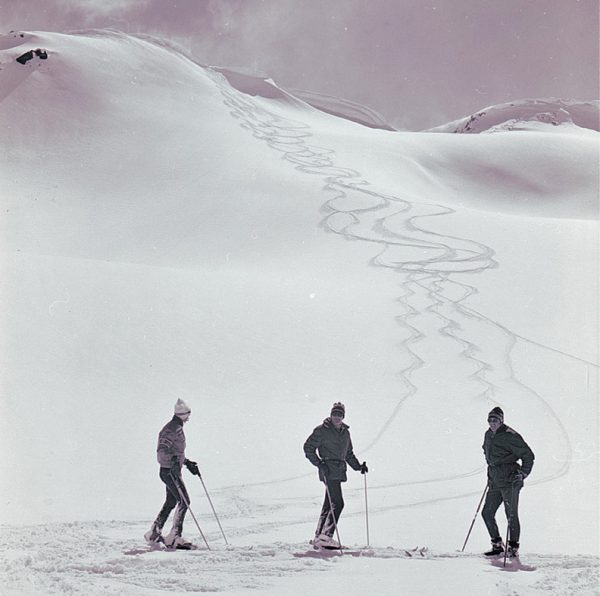
NEW WORDS IN THE DICTIONARY
Sure, Wiegele gets stick for speaking a mélange of neither English nor German—Germglish is a thing, after all—but we must recognize his contribution to the lexicon of ski life with the invention of “heli-belly”: n. the notable tendency to gain weight during a week of vigorous heli-skiing and the crazy contradiction therein. The phenomenon derives, in fact, from the grumpy guy in the big white hat, Executive Chef Toni Spori, who has been cooking up the most delicious creations in Canada and teaching the world to swear in Swiss-German since 1990. Gopfetori, huere Dotsch!
UNIQUE GUIDING CREDS
In 1990, Wiegele founded and developed the Canadian Ski Guide Association (CSGA) to train young Canadians as guides specifically for mechanized backcountry skiing. All his guides are also ski instructors and hold a minimum CSIA Level III.
RECOGNITION WHERE IT’S DUE
In 1990 the Governor General presented Wiegele with the Bravery Award, which followed the Jim Marshall Award for Excellence from the Canada West Ski Areas Association for outstanding contribution, exceptional skills and dedication to skiing. This year, he was awarded a Doctor of Laws from Thompson Rivers University, B.C.
WHERE HAVE ALL THE GOOD TIMES GONE?
No one disputes the world has gone PC, and skiers already miss the crazy wackadoodle good ol’ days. The bring-your-own-pole girls. The take-your-pants-off-at-the-door parties. The topless girls skiing down to the heli-pickup, all in a row. That would never happen these days, if only because guides go ballistic if you don’t leave at least five turns of spacing. Heli-skiing in its heyday was a summer camp in the snow for hijinks and high spirits. Long may it live in our memories.
